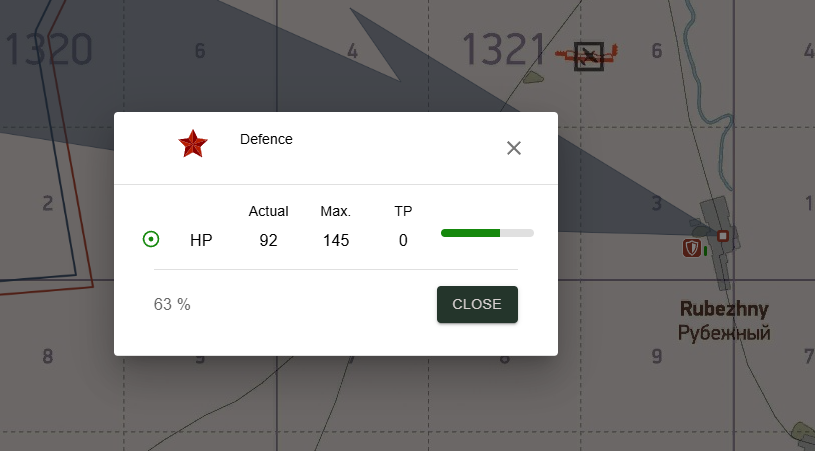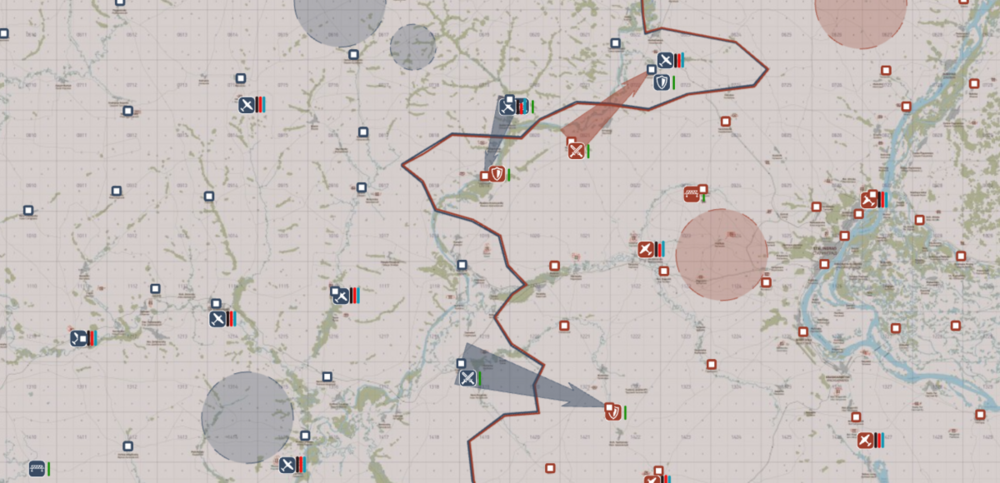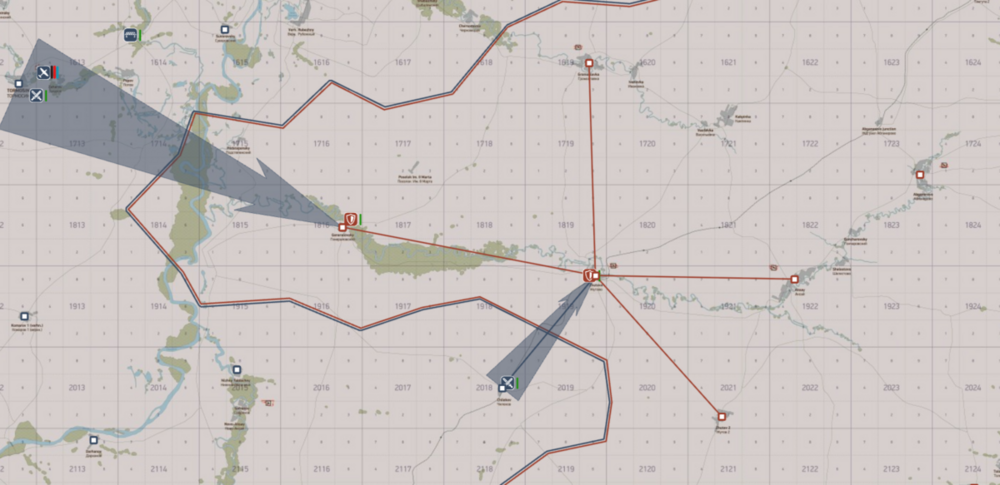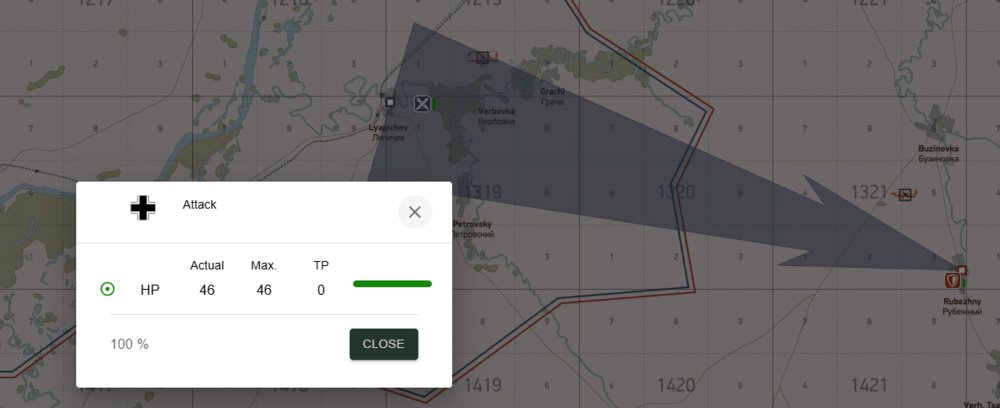The FRONT LINE Game Server Concept.
The project is positioned by its developers as a virtual war consisting of a sequence of Theaters of Operations (TOs)—separate game maps—that follow one after another. A TO can conclude either by capturing territory or by reaching its time limit. Each TO, in turn, is composed of a series of missions featuring a dynamic front line, diverse weather conditions, resource consumption, and the influence of previous mission outcomes on the current one, the overall TO, and the entire campaign. The server utilizes the highest difficulty settings currently available and features its own statistics, a personal hangar system, and a ranking system. A number of complex and engaging mechanics, as well as useful tools for players, are implemented on the server.
The project is designed for and encourages team play, stimulating coordination and interaction between squads and the unification of efforts from lone players with other participants in the virtual conflict. Not only virtual pilots but also player-controlled ground forces take part in the virtual war, which undoubtedly adds flexibility and variety to team actions.
Throughout the campaign, the server rewards or imposes restrictions on the player based on their actions, making the project highly challenging and engaging, as there is always room for growth and something to lose. This undoubtedly fosters a more responsible attitude towards virtual combat operations.
The system for determining the campaign winner allows sides to compete with interest until the very end of the virtual war. In each mission, teams earn Team Points based on the success of their actions. These Team Points accumulate, and at the campaign's conclusion, the winner is determined by the total score.
The project is still in an active development phase. The developers have a whole range of exciting ideas they are eager to implement, so we encourage you to share information about the project with your friends on social media. Also, please point out any inaccuracies or clear errors you find in the comments.
Garrisons.
Garrisons are abstract forces stationed in settlements, marked on the interactive map with red and blue icons  .
.
Garrisons are the foundation for front line movement, offensive actions, logistics, and the economy. All garrisons form a connected graph. Each settlement that houses a garrison has several important functions and conditions:
Attacking an opposing garrison. A mandatory condition is a connection to an opposing garrison (i.e., the garrison must be directly on the front line) and an actual strength of 60% or more of its maximum strength;
Defending its section of the front;
Providing operational support with reserves to garrisons located directly on the front line, mandatory conditions are a connection to an allied garrison on the front line and a mandatory lack of connection to an opposing garrison;
Про связи и поддержку резервами читайте в описании мостов:
Attention!
Not all settlements contain a garrison! Only those marked on the interactive map do! Furthermore, a settlement not marked on the interactive map does not belong to any coalition, and the destruction of its buildings is not counted in the statistics.
Garrison Strength.
All garrisons have individual values for maximum strength, actual strength, a damage indicator (each point of destruction equates to one point of strength), and the amount of strength participating in an attack or defense. Besides supporting allied front-line forces, strength is used for offensives and repelling enemy attacks. Each side can set up to two attacks per mission. Without sufficient strength, a garrison cannot attack, and the ability to attack in a specific location can be of critical importance.
Garrison strength is determined by the number of game objects within the settlement. Each game object consists of an array of sub-objects, each having one "life" (which is accounted for when it is destroyed in-game). Thus, when a building in a settlement is destroyed, the garrison's strength is reduced along with it. Each "life" = 1 point of strength.
[
{
"keyLog": "static_pass",
"model": "graphics\\blocks\\static_pass.mgm",
"script": "LuaScripts\\WorldObjects\\Blocks\\static_pass.txt",
"lives": 1,
"typeRes": "Prov",
"capacity": 3000,
"price": 46,
"points": 10,
"nameRu": "Пассажирский вагон",
"nameEn": "Passenger wagon",
"classObject": "vehicle_static",
"baseClass": "block"
},
{
"keyLog": "town_eu_med_block_02_03",
"model": "graphics\\blocks\\town_eu_med_block_02_03.mgm",
"script": "LuaScripts\\WorldObjects\\Blocks\\town_eu_med_block_02_03.txt",
"lives": 45,
"typeRes": "Prov",
"capacity": 100,
"price": 30,
"points": 3,
"nameRu": "Среднее строение",
"nameEn": "Medium building",
"classObject": "building",
"baseClass": ""
}
]Above, we see that the static_pass object has only one "life" (the lives parameter), while the town_eu_med_block_02_03 object has 45 "lives."
Expenditure of Garrison Strength.
Garrison strength can be expended as a result of combat clashes, air raids on the garrison, supporting allied forces with reserves, encirclement, and an enemy breakthrough of the front line.
Supporting Allied Forces.
The support of allied forces is described in detail in the article about bridges and is called the "transfers" mechanic:
Air Raids on the Garrison.
The concept of air raids is straightforward. Each object in a settlement contains a certain number of "lives," and each life equals 1 point of strength. By destroying objects in the settlement, you also damage the garrison. In this simple way, the garrison's strength is depleted.
Combat Clashes.
When an attack or defense is established, forces (garrison strength) are deployed from the settlement to engage in battle. After the battle concludes, these forces return to the settlement, but with losses factored in. Attackers deploy 60% of their strength from the settlement, while defenders deploy 30%. The interactive map's "In Combat" column records the amount of garrison strength participating in the local clash. After the mission ends, the forces return to their respective garrisons.
If an attack or defense takes damage, the number of forces involved decreases. In this case, after the mission ends, the forces return with their losses accounted for, thus depleting the garrison's strength in the battle for that front sector. If an attack or defense remains undamaged by the end of the mission, the forces deployed return to their garrison at full strength.
Encirclement ("Pocket").
When a garrison is encircled, its strength depletes over time on its own, even if the opposing team takes no action against it. For every mission spent encircled, the garrison loses 30% of its maximum strength until its actual strength drops to 30% of its maximum. A garrison with 30% or less of its maximum strength ceases to effectively resist, and the settlement it occupies falls under the control of the opposing team.
If more than one garrison is in a pocket, the first one to lose strength in the manner described above is selected. This is typically the weakest garrison among all those encircled. Then, once one surrenders, the next is chosen, and so on, until the pocket is completely eliminated or the encirclement is broken.
Attention!
A garrison is considered encircled (in a pocket) if it is completely isolated from allied forces. If a garrison has a connection to allies outside the TO (located on the edge of the map), it is not considered encircled and is not subject to the rules of strength loss without player intervention.
Front Line Breakthrough.
A front line breakthrough occurs when, as a result of a mission, a settlement falls under the control of the attacking side. When this happens, all defending garrisons connected to the one that just lost the battle are forced to urgently plug the gap. Since these are emergency measures, they are considered less effective and are accompanied by high losses. Thus, the connected garrisons lose 40% of their actual strength simply for being adjacent to the breakthrough. An exception is made for garrisons that already have an attack or defense order established; such garrisons are not subject to this rule.
After a front line breakthrough, and after all losses from these emergency measures are calculated, a check is performed for each garrison adjacent to the breakthrough (excluding those with an active attack or defense). If a garrison has less than 30% of its maximum strength remaining, the settlement it occupies falls under the control of the attacking side. This mechanic is called a "collapse of the front."
As an example, consider the configuration in the image:
Let's imagine the blue attack from square 2018 is successful. As a result, all red garrisons connected to the defending one (with the exception of 1816, as it has its own defense order) will automatically have their actual strength reduced by 40%. After that, a check will be performed to see how much strength remains in each of them. If it's less than 30%, the reds lose control; if more, they retain it. This means that in the image, we see a potential capture of up to four settlements by the blue side. Furthermore, the aforementioned garrison in 1816 ("Generalovsky"), even if it withstands its own attack, will become completely encircled.
The Front Line.
For the first mission of a TO (the first mission on a new map), a front line is generated that assumes both sides will have equal starting conditions.
The front line on the FRONT LINE server is dynamic. Its configuration changes between missions based on the results of the previous one, unless, of course, it is the first mission of a TO. There can be multiple front lines within a single TO, including "pockets" (the complete encirclement of one or more garrisons). This short video demonstrates various possible front line configurations:
Attacks and Defense.
Attacks.
Each side has the opportunity to set up to two attacks per mission. The ability to set attacks depends on the strength of the garrisons located on the front line. If a side has no garrisons on the front line with sufficient strength to attack, no attacks are set, and the mission is played without them.
Attack Strength.
Attack strength is not dependent on garrison strength. The actual value of an attack's strength is calculated based on the number of "lives" of the objects that make up the target. These can be tanks and other game objects. Attack strength is expressed as a relative value—the ratio of its actual strength (in real terms) to its maximum strength. In the attack dialog box on the interactive map, this value is shown in the bottom-left corner of the window. In this case, it is 100% strength.
Setting Attacks.
Currently, attacks are set by the mission generator. In the future, we plan to implement a tool for players to set attacks via the interactive map. But for now, an advanced algorithm is used to set attacks. The algorithm is as follows:
Garrison Selection. All garrisons located on the front line that are capable of attacking are selected. This means they must have at least one connection to an opposing garrison and at least 60% actual strength.;
Attack Options. The program then iterates through each selected garrison, establishes a virtual attack (considers a specific attack option), and assigns it effectiveness points. Effectiveness is evaluated based on several criteria:
The presence of an airfield within the settlement's territory grants **+20 effectiveness points;
Evaluation of the distance to the nearest enemy factory. The closer the attacked garrison is to a factory, the more effective the attack is considered. First, the distance is calculated, and an inversely proportional value is derived. For example:
At a distance of 100,000 meters to a factory,
1effectiveness point is assigned;At a distance of 64,000 meters,
1.64effectiveness points are assigned;At a distance of 38,000 meters,
2.63effectiveness points are assigned;At a distance of 10,000 meters,
10effectiveness points are assigned;
Evaluation of the condition of units adjacent to the attacked garrison. Each neighboring garrison is evaluated separately, but the scores are ultimately summed up and added to the previous effectiveness points. The evaluation is based on the ratio of actual strength to maximum strength. The weaker the neighboring garrison, the more effectiveness points are assigned. The formula is simple:
points = 1 + (max_strength - actual_strength) / max_strength. After summing the points for all neighbors, the total is doubled. For example, if an attacked target has three neighbors (actual_strength / max_strength), the sum would be 4.97, and the result 9.94:(193 / 373) result:
1.48effectiveness points;(25 / 100) result:
1.75effectiveness points;(133 / 520) result:
1.74effectiveness points;
Evaluation of the effectiveness of a simulated capture of the attacked settlement. During the simulation, the number of connected components of the graph is tracked. If the number of connected components changes after the capture, the attack is assigned the highest number of effectiveness points: 100. This means that if capturing a settlement leads to the formation of an encirclement (a "Pocket") or, conversely, breaks a previously established encirclement, such an attack is considered the highest priority.;
Attack Prioritization. Based on the results, all attacks are sorted into three lists—high, medium, and low priority—depending on the points scored in the previous stage (any attack with over 100 points goes into the high-priority list and is sorted in descending order; the rest are split in half, sorted, etc.).;
Final Selection. Finally, if there are attacks in the high-priority list, random ones are chosen from it. For example, if there is only one attack in the high-priority list, it will be chosen. If there are two or more, two high-priority attacks will be chosen, and the lower-priority lists will not be considered. The process continues down the priority lists. Most often, of course, medium-priority attacks are chosen when there are no high-priority ones. It is rare for the process to reach the low-priority list.
Attention!
You cannot attack a garrison that already has an active attack or defense! This rule can be critically important in some cases, as whoever sets an attack first claims the spot. And that spot might be essential for one of the sides, for example, to break an encirclement or to create one. To ensure fairness, on even-numbered game dates, one side gets the right to set the first attack, and on odd-numbered dates, the other side does. Sides set their attacks in turns. First one side, then the opposing side, then the first side again, and so on.
Attack Success.
The success of an attack is evaluated after the mission ends. The success criterion is very simple: at the moment the mission concludes, the attack's strength must be at least 30% greater than the defense's strength. The ratio is considered relative to the defense's strength in percentage points. That is, if an attack has 100% strength and the defense has 100% strength, the ratio is equal, and the battle is considered a draw. The front line does not change. Below are several scenarios to fully illustrate the mechanic:
Attack 100%, Defense 71% - Result: The front line does not change. The attack is considered unsuccessful;
Attack 100%, Defense 69% - Result: The front line changes; the attacked settlement falls under the control of the attackers. The attack is considered successful;
Attack 65%, Defense 45% - Result: The front line does not change. The attack is considered unsuccessful;
Attack 30%, Defense 0% - Result: The front line changes; the attacked settlement falls under the control of the attackers. The attack is considered successful;
Attack 29%, Defense 0% - Result: The front line does not change. The attack is considered unsuccessful;
Thus, reducing an attack's strength below 30% automatically renders it unsuccessful!
Tank Strength Cost.
Ground vehicle spawns are placed near attacks. The appearance of any ground vehicle unit results in a deduction of a certain amount of strength from the attack. The exact amount of strength deducted depends on the mass of the ground vehicle, which can be found on the gameset page. The calculation is done using a simple formula: strength_cost = vehicle_mass / 10000. If the resulting value is less than 1, it is set to 1.
For example:
The "Churchill IV" tank has a mass of 40,500 kg.
40,500 / 10,000 = 4.05. Rounded to 4. This will be the amount of strength the attack loses when this tank spawns;The "GAZ-MM 72K" mobile anti-aircraft artillery has a mass of
2,880 kg. 2,880 / 10,000 = 0.28. Rounded up to 1. This will be the amount of strength the attack loses when this vehicle spawns;
You cannot spawn at an attack that does not have sufficient strength for it!
Restoring Tank Strength Cost.
The strength cost from tanks can be returned to the attack! When a player exits the session (returns to briefing), if the exit occurs on allied territory, all tank-related strength is returned to the attack from which it was deducted upon spawning. If all objects comprising the attack have been destroyed, the strength is not returned.
Defenses.
A defense is always established in the territory of a settlement being attacked by the enemy. A defense is not established without an attack. The defense does not depend on the garrison's strength. A garrison will always mount a defense against an attack, even if it has insufficient actual strength (e.g., strength is 0).
Defense Strength.
Like attack strength, defense strength does not depend on garrison strength. In real terms, defense strength is calculated based on the number of "lives" of the objects that make up the target. Defense strength is expressed as the ratio of its actual strength to its maximum strength. In the defense dialog box on the interactive map, this value is shown in the bottom-left corner of the window. In this case, it is 65% strength.

Defense Success.
The success of a defense is evaluated after the mission ends. The evaluation criterion is very simple: the defense must not be weaker than the attack by more than 30%. The success of a defense is entirely dependent on the success of the attack. If the attack is evaluated as successful, it means the defense has failed. For examples of various battle outcomes, see the "Attack Success" section above.
Tank Strength Cost for Defenses.
The tank strength cost for defenses is completely analogous to the strength cost for attacks.
We wish you successful flights and a clear six!






Create an account or sign in to leave a review